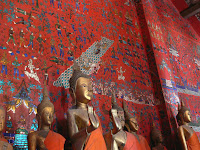
At the temple on top of Pousi Hill in the center of Luang Prabang, a large crowd had gathered by our standards. For most of this first day in the country, we had had the wats to ourselves. Yet in spite of the mob, conversations were hushed, almost mumbled, as the sun set spectacularly behind the peaks on the opposite side of the Mekong River.
A steady breeze ruffled the trees as we followed the sun and headed down. Dusk had fallen by the time we reached the gate. The town felt as if it were yawning all at once.
I expected that when we stepped into the street, we would find empty sidewalks, and restaurants that had already finished serving. But instead we turned onto a sort of parade route, a narrow walkway lined with vendors of all ages and descriptions, mostly sitting on mats on the ground, surrounded by their wares, silently waiting next to a candle or a bare battery-powered light bulb.
It was off season, so the town wasn’t packed with visitors. Also, the early evening hour meant that peak shopping hours were still to come. Still, it seemed to me that there wasn’t an empty slot anywhere along the sidewalk or along the middle of the street to squeeze another salesperson. They were all entirely set up, their goods arranged in colorful, attractive patterns.
 As we walked among them, I had the sense of being treated almost like visiting royalty, stepping slowly down a sort of red carpet of commerce. The most anyone said to us was, “Sabaidee.” The sounds I associate with markets in Thailand—boomboxes bumping, hawkers calling out “Good evening, sir,” TVs on in the background—were all absent.
As we walked among them, I had the sense of being treated almost like visiting royalty, stepping slowly down a sort of red carpet of commerce. The most anyone said to us was, “Sabaidee.” The sounds I associate with markets in Thailand—boomboxes bumping, hawkers calling out “Good evening, sir,” TVs on in the background—were all absent.
Perpendicular to the market street, with its sarongs, t-shirts, hilltribe dolls, cotton pants, shoulder bags, wall hangings, and whatnot, was an alley. Its noises were a bit more familiar—lots of giggling and shouting among salespeople. Yet along the main drag, the merchants might just as easily have been worshiping or waiting to offer alms to monks. (Less than twelve hours later, we did just that along that same strip, surrounded by the same surreal silence).  I wouldn’t have been surprised had some of the vendors suddenly prostrated themselves as we walked past.
I wouldn’t have been surprised had some of the vendors suddenly prostrated themselves as we walked past.
Just to add to the general dreamlike quality of the scene, when we reached the end of the night market, and were waiting for everyone to be accounted for, I looked up at a handsome balcony attached to a colonial-era building. The sun had long since set, and the view from that balcony didn’t face anything especially scenic, so at first I was surprised to see three Westerners up there, apparently gesturing wildly toward some object in the distance. The longer I watched them, the more I could see that their gestures were really ritual bows, performed regularly and quickly, in time with a beat that I couldn’t hear. Then I figured it out—it was Friday night, the hour for the observant Jews of Luang Prabang to say “shabat shalom.”









